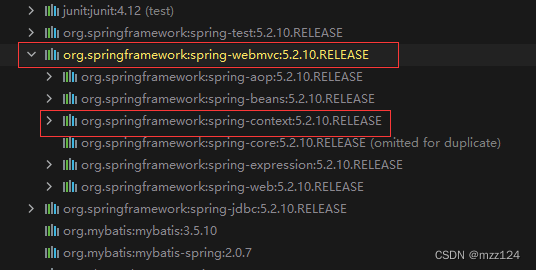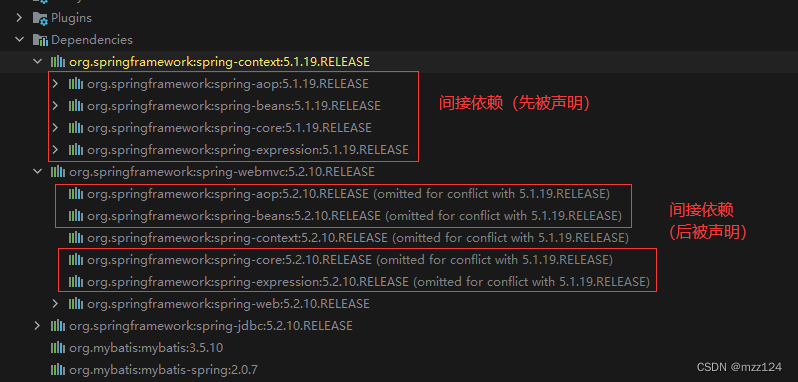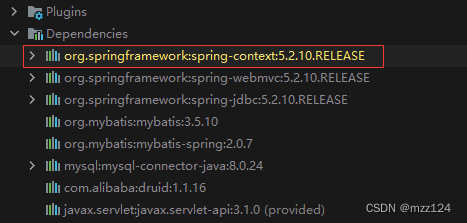Maven依赖管理的用法介绍
一、依赖传递
1. 直接依赖与间接依赖
pom.xml 声明了的依赖是直接依赖,依赖中又包含的依赖就是间接依赖(直接依赖的直接依赖),间接依赖虽然未被声明,但也是依赖所必须的依赖,同时间接依赖中的资源也可以直接使用
比如 A 依赖了 B,B 依赖了 C,那么 A 也就间接的依赖了 C,如果没有 C,那么 A 和 B 都无法正常运行,A 也可以直接使用 C 的内容,而可以不必再声明 C
实例如 spring-webmvc:
<dependency>
<groupId>org.springframework</groupId>
<artifactId>spring-webmvc</artifactId>
<version>5.2.10.RELEASE</version>
</dependency>
学习 Spring 时需要导入 spring-context 依赖,但学习 SpringMVC 时,我们会导入 spring-webmvc,此时即便会用到 Spring 的功能也无需再导入 spring-context。因为 spring-webmvc 依赖了 spring-context,spring-context 作为间接依赖被引入到了项目中,可以直接使用

2. 依赖传递冲突时的优先规则
假如一个项目中或直接或间接的多次导入了同一个依赖,就会产生依赖冲突,此时 Maven 会按照下面三种优先规则确定真正依赖的是哪个包:(主要讨论不同版本的依赖,相同版本没什么所谓)
(1) 路径优先
直接依赖优先级最高,其次是间接依赖,然后是间接依赖的直接依赖,间接依赖的间接依赖 ……
层级越深,优先级越低,或者说就近原则,离项目最近的包就是项目真正所依赖的
如下例:
<dependencies>
<dependency>
<groupId>org.springframework</groupId>
<artifactId>spring-context</artifactId>
<version>5.1.19.RELEASE</version>
</dependency>
<dependency>
<groupId>org.springframework</groupId>
<artifactId>spring-webmvc</artifactId>
<version>5.2.10.RELEASE</version>
</dependency>
</dependencies>
示例中引入了 spring-context 5.1.19 为直接依赖,又引入 spring-webmvc 5.2.10,其中又依赖了 spring-context 5.2.10,但它是间接依赖,所以项目中所使用的 spring-context 资源是 5.1.19 版本的(但并不代表 webmvc 中的 context 版本也被改为了 5.1.19),图中也可以看到 IDEA 在依赖后边给出了冲突标识
(2) 声明优先
相同层级的依赖资源,先被声明的优先
如下例:(和刚才的一样)
<dependencies>
<dependency>
<groupId>org.springframework</groupId>
<artifactId>spring-context</artifactId>
<version>5.1.19.RELEASE</version>
</dependency>
<dependency>
<groupId>org.springframework</groupId>
<artifactId>spring-webmvc</artifactId>
<version>5.2.10.RELEASE</version>
</dependency>
</dependencies>
和上面一样导入 spring-context 5.1.19 和 spring-webmvc 5.2.10,可以看到 context 和 webmvc 都又依赖了 aop, beans, core 等几个包,且都是间接依赖,层级相等,但由于先声明的 context 5.1.19,所以其中的 aop, core 等几个包的优先级更高
(3) 后声明覆盖先声明
同时声明了同一个依赖的不同版本,那么先声明的版本会被最后声明的版本覆盖掉(以最后一次声明为准)
如下例:
<dependencies>
<dependency>
<groupId>org.springframework</groupId>
<artifactId>spring-context</artifactId>
<version>5.1.19.RELEASE</version>
</dependency>
<dependency>
<groupId>org.springframework</groupId>
<artifactId>spring-context</artifactId>
<version>5.2.10.RELEASE</version>
</dependency>
</dependencies>
先声明 spring-context 5.1.19,又声明了 spring-context 5.2.10,最后使用的依赖版本为 5.2.10
二、依赖管理
分模块开发时,合理的管理依赖能够避免掉依赖冲突可能带来的麻烦。
1. 可选依赖
用于对外隐藏本项目中使用的依赖。如果项目中将某个依赖设置为可选依赖,那么其他项目引用此项目时不会加载到可选依赖。
只需在声明依赖时加入 optional 标签,设置值为 true 即可(默认为 false)
<dependency>
<groupId>org.springframework</groupId>
<artifactId>spring-context</artifactId>
<version>5.1.19.RELEASE</version>
<optional>true</optional>
</dependency>如上设置后,其他项目引入此项目时,不会加载到此项目中的 spring-context 5.1.19
2. 排除依赖
引入依赖时,用于排除掉该依赖中传递来的指定依赖。
需要在声明依赖时加入 exclusions 标签,内含多个 exclusion,设置 要排除的依赖坐标,不必指定版本
<dependency>
<groupId>org.springframework</groupId>
<artifactId>spring-webmvc</artifactId>
<version>5.2.10.RELEASE</version>
<exclusions>
<exclusion>
<groupId>org.springframework</groupId>
<artifactId>spring-aop</artifactId>
</exclusion>
<exclusion>
<groupId>org.springframework</groupId>
<artifactId>spring-core</artifactId>
</exclusion>
</exclusions>
</dependency>如上设置后,本项目不会加载 spring-webmvc 依赖中包含的 spring-aop 和 spring-core
3. 可选依赖与排除依赖的异同点
相同点:
- 功能相同:都用于阻断依赖的传递
不同点:
- 原理不同:可选依赖对外不透明,排除依赖有传递但不采用
- 生效时机不同:可选依赖生效在项目被引入时,排除依赖生效在引入其他项目时
到此这篇关于Maven依赖管理的用法介绍的文章就介绍到这了,更多相关Maven依赖管理内容请搜索编程学习网以前的文章希望大家以后多多支持编程学习网!
